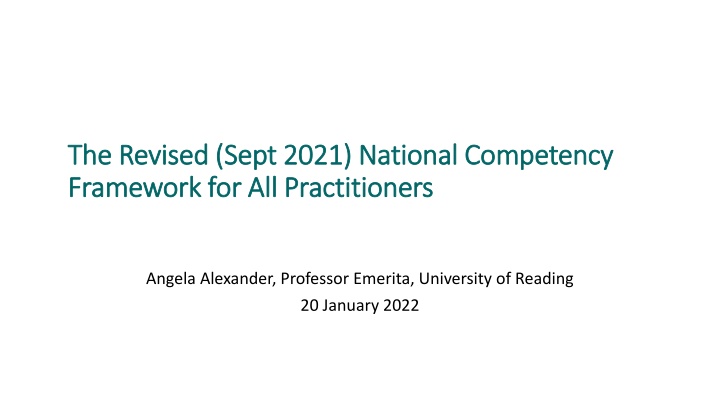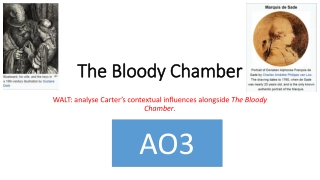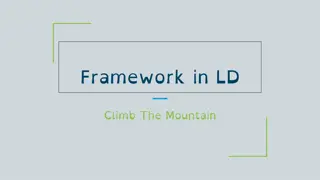
Updated National Competency Framework for Prescribing Practitioners
The revised national competency framework for all prescribing practitioners has been updated to reflect changes in legislation and key prescribing topics. Key themes include consultation settings, health literacy, social prescribing, sustainable prescribing, and supporting others in prescribing. The framework now includes 76 supporting statements, 12 new ones, and additional information sections for clarity and examples, with a stronger focus on scope of practice and professionalism. Endorsed by various healthcare associations, the framework aims to ensure quality and safe prescribing practices.
Download Presentation

Please find below an Image/Link to download the presentation.
The content on the website is provided AS IS for your information and personal use only. It may not be sold, licensed, or shared on other websites without obtaining consent from the author. If you encounter any issues during the download, it is possible that the publisher has removed the file from their server.
You are allowed to download the files provided on this website for personal or commercial use, subject to the condition that they are used lawfully. All files are the property of their respective owners.
The content on the website is provided AS IS for your information and personal use only. It may not be sold, licensed, or shared on other websites without obtaining consent from the author.
E N D
Presentation Transcript
The Revised (Sept 2021) National Competency The Revised (Sept 2021) National Competency Framework for All Practitioners Framework for All Practitioners Angela Alexander, Professor Emerita, University of Reading 20 January 2022
My task (and yours) My task (and yours) the revised framework: what has changed? deadlines for implementation what does good prescribing look like? Competency dimensions how the national framework can be used in practice levels of prescribing competence the competency framework for designated prescribing practitioners moving forward and current issues
So why did we need a revised framework? So why did we need a revised framework? Since the 2016 framework, there have been various changes which needed to be included in the update of the framework these include: Legislation changes introducing paramedic prescribers in April 2018 Current prescribing topics such as remote prescribing, social prescribing, psychosocial assessment and eco-directed sustainable prescribing. Further key themes can be found in the table below Publication of the RPS Competency Framework for Designated Prescribing Practitioners in December 2019
The revised framework: what has changed? The revised framework: what has changed? New key themes were added e.g. consultation setting, health literacy, social prescribing, sustainable prescribing, reducing waste, and supporting others prescribing (DPP) Now 76 supporting statements 12 new ones New further information sections added to provide clarity and give examples The professionalism section is now integrated into the framework with more focus on scope of practice
Endorsed by: Endorsed by: Association For Prescribers British Dental Association British Dietetic Association British Pharmacological Society Chartered Society of Physiotherapy College of Optometrists College of Paramedics Joint Council For Cosmetic Practitioners Pharmaceutical Society of Northern Ireland Royal College Of Midwives Royal College of Nursing Royal College of Podiatry Society of Radiographers Royal College of General Practitioners And not forgetting Patients!
Structure of the framework TWO DOMAINS COMPETENCY AND SUPPORTING STATEMENTS FURTHER INFORMATION 6
9. Improve prescribing practice 9.1 Improves by reflecting on own and others prescribing practice, and by acting upon feedback and discussion. 9.2 Acts upon inappropriate or unsafe prescribing practice using appropriate processes.a 9.3 Understands and uses available toolsb to improve prescribing practice. 9.4 Takes responsibility for own learning and continuing professional development relevant to the prescribing role.c 9.5 Makes use of networks for support and learning. 9.6 Encourages and supports others with their prescribing practice and continuing professional development.d 9.7 Considers the impact of prescribing on sustainability, as well as methods of reducing the carbon footprint and environmental impact of any medicine.e 7
9. Further information on the supporting statements a Processes include whistleblowing, regulatory and professional guidance, and employer procedures. b Tools include supervision, observation of practice and clinical assessment skills, portfolios, workplace competency-based assessments, questionnaires, prescribing data analysis, audits, case-based discussions, personal formularies and actively seeking regular patient and peer feedback c By continuously reviewing, reflecting, identifying gaps, planning, acting, applying and evidencing learning or competencies. d By considering mentoring, leadership and workforce development (for example, becoming a Designated Prescribing Practitioner). e Methods of reducing a medicine s carbon footprint and environmental impact include proper disposal of medicine/device/equipment waste, recycling schemes, avoiding overprescribing and waste through regular reviews, deprescribing, dose and device optimisation. 8
Deadlines for implementation Deadlines for implementation Publication date: September 2021 Effective date: by September 2022 Next review date: September 2026
What does good prescribing look like? What does good prescribing look like? (and who is best to ask?) (and who is best to ask?)
How the national framework can be used in How the national framework can be used in practice practice Attending networking/learning events Audits Case studies Case-based discussions CPD records Looking at prescribing data analysis Observation of practice and clinical assessment skills Peer discussions & feedback Personal formularies Portfolios mapped to competencies Questionnaires and patient feedback. Reading articles, SOPs, guidelines, processes in practice Real life practice examples Reflective accounts - identifying gaps Setting SMART objectives Supervision Video recordings (consent) Workplace competency-based assessments
Levels of prescribing competence Levels of prescribing competence Where is your confidence in all of this too? The framework should help to boost your confidence in prescribing too.
The competency framework The competency framework for Designated Prescribing for Designated Prescribing Practitioners Practitioners regulatory changes in 2018/19 enabled some non-medical prescribers (NMPs) to take on role of supervising and confirming competence during the period of learning in practice in addition to Designated Medical Practitioners (DMPs) there was a need to ensure that those who took on the role were suitable framework was developed with representatives from all prescribers, regulators, education providers and patients.
Structure of the DPP Structure of the DPP competence framework competence framework
Moving forward and current issues Moving forward and current issues Go to https://www.rpharms.com/resources/frameworks/prescribers- competency-framework and https://www.rpharms.com/resources/frameworks/designated- prescribing-practitioner-competency-framework Identify your gaps in relation to your own practice and current and future issues e.g. different consultation models, extending scope of practice Find the resources to help you to move your competence to level 3 and 4 for all the statements
Any questions
Small group breakout sessions From what you ve heard so far what competencies do you need to develop for the future? What resources do you have to support your learning for those competencies?






















